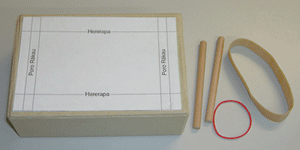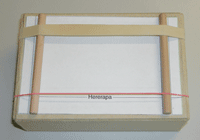| Approach: One
to one |
 |
1.2Mb |
|
| Focus:
Sound
generation and transmission
|
| Resources:
“Banjo
box”, coloured and brown rubber bands, 2 pieces of dowel,
picture |
He
whakatau kupu: hererapa
= rubberband, whaikano = coloured, autangi = musical instrument
picture puare = opening/hole |
|
| Questions/instructions:
Ko
te kaupapa o tënei mahi, he äta whakaaro ki tënei
mea te oro, me te whakaputa oro.
Tuatahi, mäku e hanga tëtahi pakakü mämä.
Waihotia te pouaka, kia rua ngä hererapa, kia rua hoki
ngä poro räkau ki te tëpu. Hangaia he pakakü,
ka whakamärama ai …
Koinei ngä rauemi hei hanga i tëtahi pakakü mämä.
Kia noho whäroa ngä hererapa ki te pouaka. Kaua e pä
tëtahi hererapa ki tëtahi. Kätahi ka whakamau i ngä
räkau ki raro i ngä hererapa kia pätata atu ki ngä
pito o te pouaka.
|
|
In
this activity we’ll be thinking about sounds and how they’re
made. First I’m going to make a simple banjo.
Place the box, two rubber bands and two pieces of dowling
on the table.
Teacher makes banjo box, telling the student.....
These are the materials I’ll use to make a simple banjo. I
put the rubber bands around the box lengthwise. I make sure the
two rubber bands are not touching each other. Then I put the pieces
of wood under the rubber bands near the ends of the box. |

[click on
picture for enlargement]
Kia
oti te pakakü te hanga, ka hoatu ki te äkonga.
Mäu e äta whakatangi ia hererapa, ka äta whakarongo
ki ngä oro.
Tukuna te äkonga kia tühura i tënei mahi. |
|
Once
the banjo has been made give it to the student.
Now I would like you to pluck each of the rubber bands and listen
carefully to the sounds the two rubber bands make.
Allow time for student to experiment. |

[click
on picture for enlargement]
|
|
%
responses
|
1.
He aha ëtahi körero hei whakamärama i ngä oro?
He äwhina: He aha ngä rerekëtanga o ngä oro?
What can you tell me about the sounds?
Prompt: What is different about them?
|
coloured
band makes higher sound/pitch |
68 |
Ki
te kore te äkonga i aro he teitei ake te oro o te hererapa whai kano,
mäu tonu e whakaari, ka körero “He teitei ake te oro o
te hererapa whai kano i te hererapa ura”.
If the student didn’t notice that the coloured rubber band made
a higher sound than the brown rubber band, demonstrate and say,
“The coloured rubber band makes a higher sound than the brown one”. |
|
2.
Tëna, whakamäramahia mai, he aha i teitei ake ai te oro o te
hererapa ura?
Try to explain why the coloured rubber band made a higher sound.
|
Explanation:
[coloured band thinner/lighter;
coloured band stretched more tightly] |
|
included
both ideas |
2 |
included
thickness/mass |
86 |
included
tension/tightness |
0 |
3.
Whakamäramahia mai, ka pëhea nei te oro e tae mai ai ki ö
tätou taringa, mai i te pakakü?
Try to explain how the sound gets from the rubber band to our ears.
|
band
makes vibrations in air which travel to ears and are heard |
12 |
vaguely
mentioned air vibrations |
22 |
4.
Ki töu whakaaro, ka pëhea ngä oro o ngä hererapa mënä
ka tangohia atu ngä poro räkau?
He äwhina: Ka pëhea nei te rerekë o ngä oro?
What do you think would happen to the rubber band sounds if we took the
pieces of wood out?
Prompt: In what way might it sound different?
|
sound
will not ring out properly,
or will stop quickly |
63 |
Tënä,
me tango atu ngä poro räkau, ka whakamätau ai.
Tangohia ngä poro räkau.
Let’s take out the pieces of wood and see what happens.
Remove pieces of wood. |
|
5.
He pehea nei te ähua o ngä oro o ngä hererapa inäianei?
What do you notice about the sounds the rubber bands make now?
|
sound
does not ring out properly
or stops quickly |
34 |
difference
in pitch (lower) |
12 |
6.
Whakamäramahia mai he aha i rereke ai ngä oro ina tangohia atu
ngä poro räkau.
Try to explain why the sounds are different when the pieces of wood are
taken out.
|
stops
bands from vibrating properly |
61 |
Whakaaturia
ngä pikitia o ngä autangi.
He autangi kei roto i tënei pikitia. He puare kei
ngä autangi katoa.
Show picture of stringed instruments.
This picture shows some stringed instruments.
Notice that they all have a hole. |
|
|
|
7.
Ki töu whakaaro, he aha te take o te puare o ënei autangi?
Why do you think these instruments have holes in them?
|
open
cavity allows sound to resonate and amplifies sound |
18 |
lets
sound in/make sound louder |
42 |
| |
|
Total
score:
|
11–13
|
4 |
8–10
|
33 |
5–7
|
40 |
2–4
|
19 |
0–1 |
4 |
Commentary:
A majority
of students suceeded with most components of this task, but few understood
how sound is transmitted by air. |